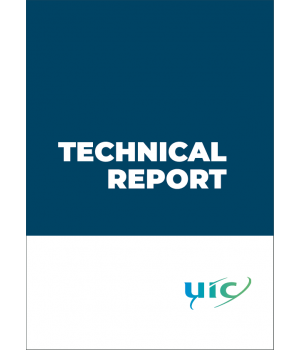
Braking Questions - Optimization of the contour of composite brake blocks to reduce the equivalent conicity - Synthesis of the results of final phase results
Several investigations in the in-service performance of composite brake blocks showed that the use of such blocks results in a different wear pattern of the wheel profile in comparison to cast iron blocks. One of the effects is the increase of the equivalent conicity which is a parameter to assess the running stability characteristics of a vehicle. Especially with some tested blocks of sinter material the equivalent conicity changes relatively fast.
In previous investigations the idea had risen that the contour of the brake block plays an important role in the wear pattern of the wheel profile and thus it was expected that the modification of the block shape could have beneficial effects for the wheel profile. Therefore in the beginning of 2009 UIC decided to start a project to optimize the shape of the brake block in order to prevent the equivalent conicity to rise. In the first phase of this project, test bench test were carried out to simulate the wheel tread wear in order to understand the problem. It came out that indeed the brake blocks influence the wear of the wheel profile but the test bench test were not an appropriate method to investigate the phenomenon. The results are reported in B 126/DT 433.
This report intents to describe and summarize the activities carried out in the second phase of the project and draw some finalizing conclusions. In this second phase of the project the influence of various brake block materials, shapes and positions on wheels in service was investigated on the EuropeTrain. Further (non)destructive investigations on the wheel tread’s material were carried out to get more insight in the mechanisms that play a role in the tread wear. The investigations gave the insight that the wheel-rail interaction plays an important role in the wear of the wheelprofile and the important differences between the brake block material, resulting in different wear rates and heat related deterioration, occur. The investigations indicate that the risk of thermal cracking might increase when using LL-brake blocks, this should be taken into account in the maintenance plans and when making LCC analysis. No major advantage of the use of modified brake block positions or shapes could be demonstrated; therefore it is not recommended to development this idea of changing the block shape as a measure to optimize LCC.
"+ "
| ISBN | 978-2-7461-2331-1 |
| Pages | 42 |
Fiche technique
- Langage
- Anglais
- Edition
- Ed. no.1
- Date d'édition
- 01/06/2014
- Date de publication
- 07/10/2014
- Nombre de pages
- 42
- Thème
- Technology Technique
- sku
- E_DT441
- Reference
- B 126 / DT 441
 Préférences sur les cookies
Préférences sur les cookies

